Selected Research Projects
We conducted different research projects (NBIF, MITACS, NSERC Engage, NSERC/Cisco IRC projects) collaborating with different companies (e.g.: Cisco, Eigen Innovation, Rimot, The Black Arcs, Codiac Transpo, HotSpot) to develop working prototypes that could be used as a template for the company's products in the future. Our research activities focus on the following topics:
- Edge Computing, Fog Computing, Cloud Computing
Combining edge, fog, and cloud resources to build an architecture for Analytics Everywhere Framework. - Internet of Things, Cyber-Physical Systems
Implementing different sensors to collect data in real time and applying them in many smart city use case studies. - Big Data Analytics, Data Science
Analyzing continous and accumulated data streams using different analytical capabilities such as descriptive, diagnostics, predictive analytics. - Machine Learning, Artificial Intelligence, Explainable AI (XAI), Contestable AI
Developing different machine learning, deep learning to perform incremental online learning, federated learning, transfer learning on data streams.
Belows are some selected projects, tutorial, outcomes from our past and current research.
XAI for Computing Visual Perception Tasks
Explainable AI/Contestable AI
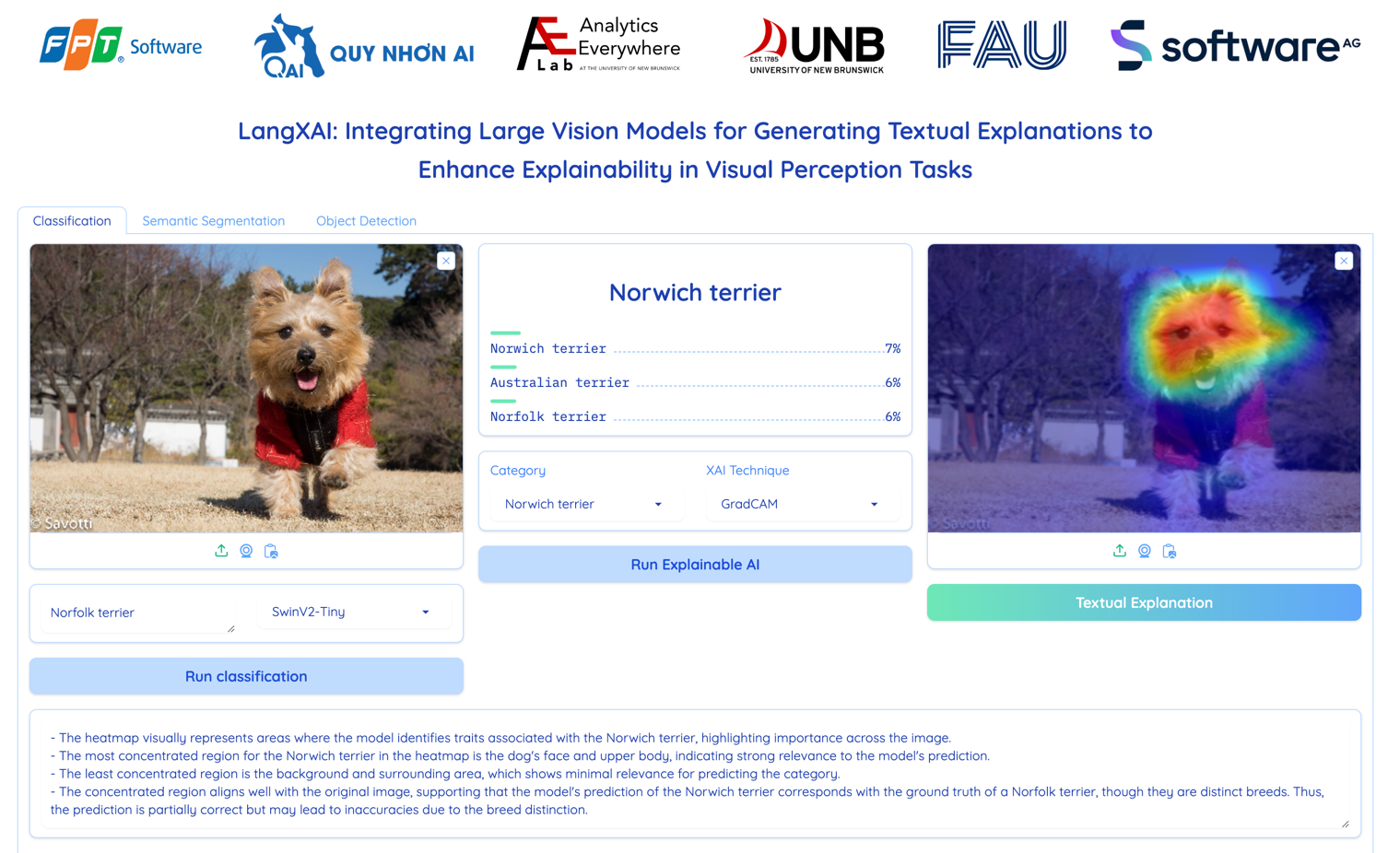
The Analytics Everywhere Lab at UNB has significantly advanced Explainable Artificial Intelligence (XAI) through several recent pioneering contributions such as G-CAME, LangXAI, and ODExAI. Our G-CAME architecture introduces a quick, interpretable method for object detection, leveraging Gaussian-weighted saliency maps to achieve high localization accuracy (96.13%) and efficiency (0.5s), ideal for real-time applications like autonomous systems. Meanwhile, the LangXAI framework enhances accessibility by integrating large vision models to generate clear, human-readable textual explanations for visual perception tasks, achieving high BERTScores and fostering trust in domains such as healthcare and banking. Additionally, ODExAI establishes a comprehensive evaluation framework, benchmarking XAI methods across localization, faithfulness, and computational efficiency, offering practical guidelines for method selection. Together, these contributions promote transparency, reliability, and standardized evaluation in AI, driving trustworthy adoption in critical sectors like education, manufacturing, transportation, services, and security, and reinforcing xAI’s commitment to human-centric AI solutions.
[Publications] [Demo Page]
Edge Quantization
Edge Computing/Federated Learning
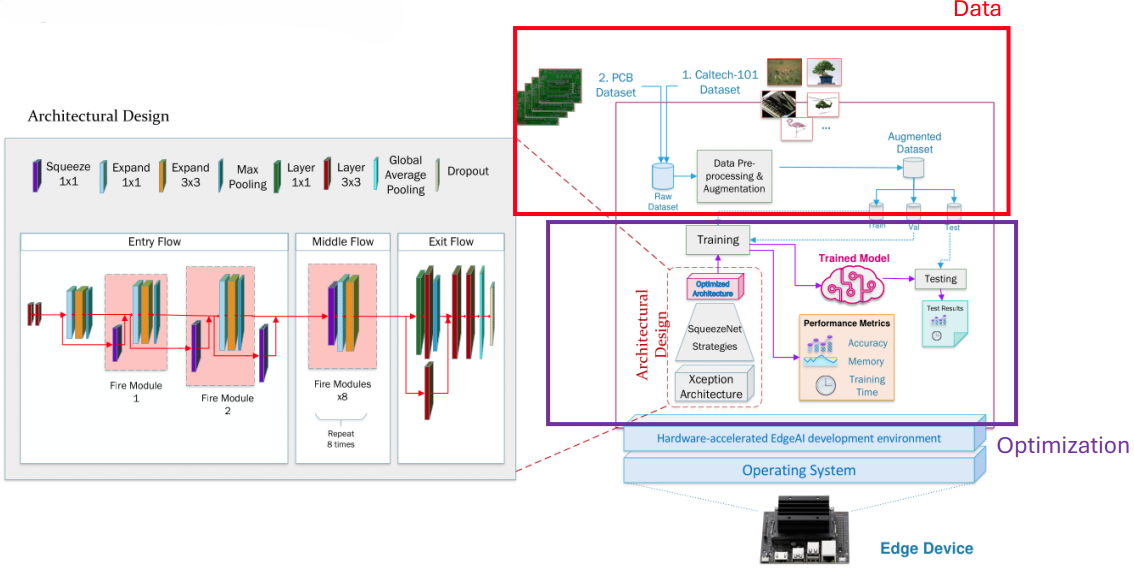
Cloud-based AI models rely heavily on external infrastructure, making them vulnerable to service outages, latency issues, and privacy concerns due to off-site data storage. Network instability and bandwidth limitations can further disrupt performance. To address these, EdgeAI shifts model training to edge devices, but resource constraints often limit applications to inference-only, with models trained in the cloud. This introduces challenges like data transfer latency and privacy risks. Our research proposes an optimized Deep Neural Network (DNN) using horizontal Compact Network Design (CND) applied to the Xception model. We achieved significant model size reduction through efficient parameter reduction strategies, lowering memory usage without compromising accuracy. This enables robust on-device training, allowing models to adapt to new data locally, improving performance and resilience in resource-constrained edge environments. This advancement enhances hardware efficiency, making EdgeAI more practical and scalable for real-world applications.
[Publications]
Heart2Mind - PAKDD
Explainable AI/Contestable AI
Psychiatric disorders (PDs) like schizophrenia and bipolar disorder impact millions globally, yet diagnoses remain largely dependent on subjective clinical evaluations. To address this issue, we developed Psychiatric Disorder Diagnosis System integrating single-lead electrocardiogram (ECG) data with the Time Series Convolutional Attention Network to capture local and global temporal patterns for detecting PDs. Our system combined dual Explainable AI (XAI) methods with Large Vision Language Models to generate textual insights, enhancing model interpretability and clinician trust. Not only using XAI to help users understand AI decisions, we also applied Contestable AI to extend this work by empowering users to challenge and potentially overturn those decisions, prioritizing actionable control over passive understanding. Consequently, we proposed Heart2Mind, a human-centered contestable psychiatric disorder diagnosis system that integrates wearable ECG monitoring with AI for continuous assessment via cardiac biomarkers. We defined contestable AI as an interactive system enabling human challenge throughout its decision-making while maintaining transparency and incorporating safeguards. Our work addressed healthcare regulations demanding meaningful contestation of AI decisions, ensuring that while leveraging advanced technology, ultimate decision-making authority remains with healthcare professionals.
[Publications]
Multimodal Ambient Context-enriched Intelligence Platform (MACeIP)
Smart City

As cities worldwide grapple with rapid urbanization and the complexities of modern growth, our pioneering research unveils the Multimodal Ambient Context-enriched Intelligence Platform (MACeIP), a transformative solution designed to redefine the future of smart cities. Harnessing the power of advanced digital technologies, MACeIP seamlessly integrates an array of innovative components, including Interactive Hubs for real-time citizen engagement, a robust IoT sensor network for data collection, intelligent public asset management, an advanced pedestrian monitoring system, a user-friendly City Planning Portal (CPP), and a scalable Cloud Computing System (CCS) driven by state-of-the-art Multimodal AI. This AI framework combines time-series and vision models, Large Language Models (LLMs), and Explainable AI (XAI) techniques to deliver a transparent, efficient, and citizen-focused decision-making platform that prioritizes sustainability and quality of life. Successfully deployed in Canadian cities, with a spotlight on Fredericton, New Brunswick, MACeIP showcases intuitive user interfaces for its Interactive Hubs and CPP, empowering communities with actionable insights and fostering inclusive urban development. Our research sets a bold new benchmark for intelligent, connected, and sustainable cities, paving the way for a smarter urban future.
[Publications]
Industrial Visual Quality Inspection Systems
Explainable AI
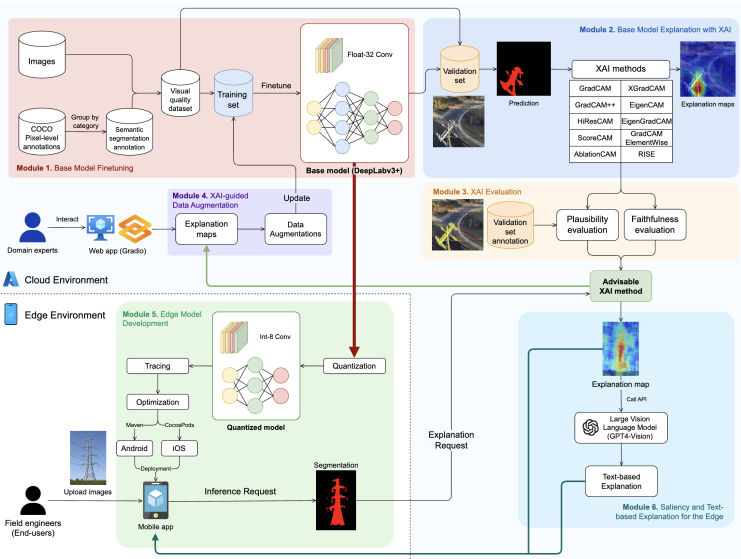
Industrial Visual Quality Inspection systems are automated tools designed to monitor and assess the condition of industrial hardware assets. Recent progress in deep learning has greatly enhanced visual quality inspection and predictive maintenance in industrial environments. However, deploying these technologies on resource-constrained edge devices remains challenging due to their high computational requirements and the complexity of Explainable AI (XAI) methods. In this work, we developed an XAI-integrated Visual Quality Inspection for industrial assets, meeting the increasing demand for explainable and trustworthy AI systems in edge computing environments. This groundbreaking research addresses the challenges of deploying deep learning technologies on low-resource edge devices by introducing a novel XAI-integrated Visual Quality Inspection framework. Our framework incorporates XAI and the Large Vision Language Model to deliver human-centered interpretability through visual and textual explanations to end-users. This is crucial for end-user trust and model interpretability. Experimental results showcase the effectiveness of the proposed framework, with the mobile model achieving competitive accuracy while significantly reducing model size. This approach paves the way for the broader adoption of reliable and interpretable AI tools in critical industrial applications, where decisions must be both rapid and justifiable.
[Publications]
Pre-impact Fall Detection with TinyML for Aging in Place
Edge Computing/Federated Learning
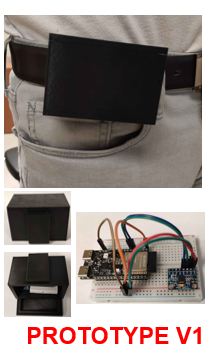
Global demographic trends show a rapidly aging population, creating significant challenges for healthcare systems and societal infrastructure. This shift requires sustainable, human-centered care models for older adults. Aging-in-place (AIP), which supports older individuals in staying in their homes and communities instead of moving to institutional care, is gaining widespread support. However, supporting AIP requires addressing critical safety and health concerns, most notably the risk of falls.
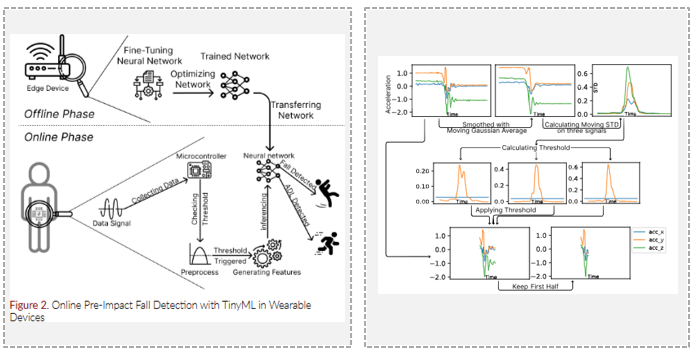
We proposed a novel online fall prediction approach leveraging Advanced Edge Computing, IoT, and TinyML. A semi-supervised federated learning-based fall detection (SF2D) method was developed that leverages edge devices to maintain user privacy while ensuring accurate detection. The prototype developed by our lab, in combination with other privacy-conscious and context-aware technologies, is vital in ensuring that AIP remains a viable, safe, and dignified option for older adults.
[Publications] [Impact Story]
Long-Range IoT Water Monitoring Prototype and Deployment
Climate Adaptation
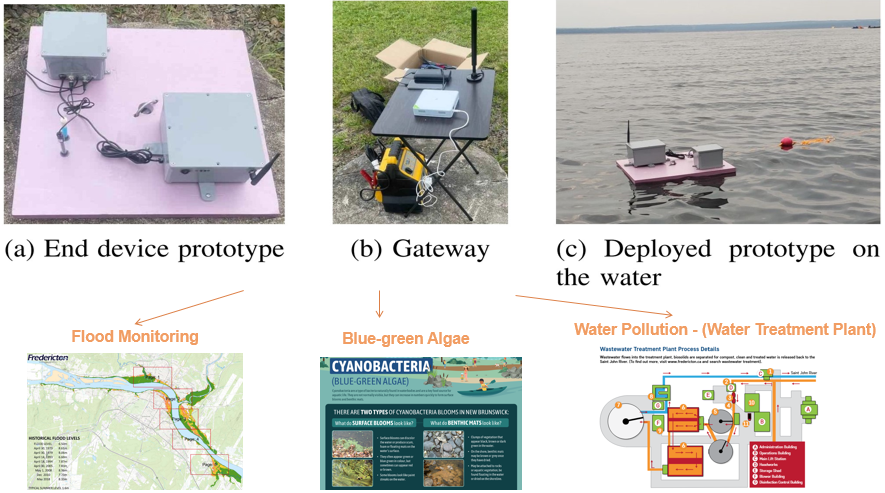
A key feature of smart cities is their ability to monitor environmental conditions and provide data-driven insights for future decision-making. Water monitoring is a vital process that involves continuously assessing water properties to ensure the safety and sustainability of water resources. These insights can benefit both governments and citizens, such as enabling the detection and prediction of environmental anomalies or informing the public about water quality for recreational activities like swimming and fishing. In this work, we proposed a real-time remote water monitoring framework utilizing an energy-efficient LoRa IoT system to address the challenge of power consumption. Our developed prototype has been tested and deployed in real-world scenarios, offering many valuable applications such as flood monitoring, detection of harmful toxins like blue-green algae, and water pollution management. This work was funded by the OFI Seed Fund and NBIF Emerging Projects Fund.
[Publications]
Graffiti Detection with EdgeAI
Smart City

Graffiti poses risks, creates liabilities, and harms heritage structures and the local economy. These destructive events are increasing rapidly in many cities across Canada, while current detection methods remain resource-intensive and slow. For example, one of our technology receptors spent over $75,000 on graffiti removal in 2023, with incidents rising from 131 in 2022 to 210 in mid-2023, and continuing to increase in 2024 and 2025. Damaged sign replacements cost between $150 and $200 each. Since target structures can be tall and close to vehicle traffic, preventing such vandalism involves multiple stakeholders. This project aims to develop an Edge AI-based platform for near real-time graffiti detection, boosting public safety and municipal efficiency. Our approach will leverage existing data streams from IoT sensors, public webcams, and other sources, and use edge devices to help users identify and predict future situations of interest promptly and effectively. A proof-of-concept focused on graffiti detection and spatio-temporal analysis is under development to forecast patterns of occurrence in other parts of the city. Municipal authorities will benefit from this project by gaining visibility into an issue that currently lacks it. Near real-time graffiti detection and spatio-temporal analytics at the edge have not been previously implemented in the context of smart cities. The adoption of the Edge AI-based information retrieval technology proposed here can also support various other smart city applications (e.g., analyzing idle times at intersections and distinguishing between recreational and active transportation).
[Publications] [Impact Story]
Smart Building Project
Smart City
Our lab are involving with the The Smart Campus Integration and Testing Lab project leading by Toronto Metropolitan University. Topics of investigation include integrating Smart City and Smart Campus management, optimizing building energy efficiency, improving occupant health and productivity, reducing carbon emissions and mitigating cybersecurity risks. One of the two remote installations in buildings at UNB will contribute data to the system.
[Latest Info]
Automated Defect Detection using Transfer Learning
Smart Manufacturing
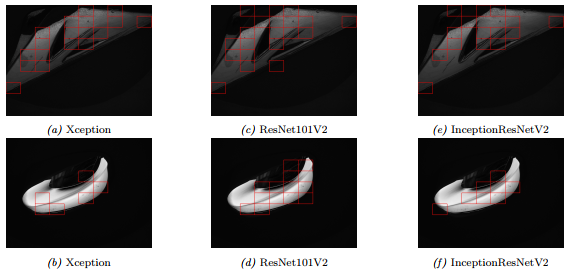
Quality assurance is crucial in the smart manufacturing industry as it identifies the presence of defects in finished products before they are shipped out. Eigen Innovations Inc. provides the solutions to help the manufacturing industry through an AI-enabled industrial vision platform to detect quality issues of the products in real-time. While the platform works very well in certain applications, it is challenging to scale and adapt algorithms to new contexts and scenarios such as new vision camera perspectives, new part geometries, etc. To assist the company to solve this problem, the Analytics Everywhere Lab at UNB, Dr. Hung Cao, and Eigen Innovations Inc. will collaborate on a joint exploratory AI-enabled project that leverages the most advantageous and latest AI technologies to improve the scalability of the company’s current defect detection models. This research project aims to identify the relevance of leveraging transfer learning techniques and synthetic data approaches to minimize the necessity for large labeled datasets at the start of each new application. This project is funded by NBIF.
[Publications] [Impact Story]
Land Mobile Radio System
Industry 4.0
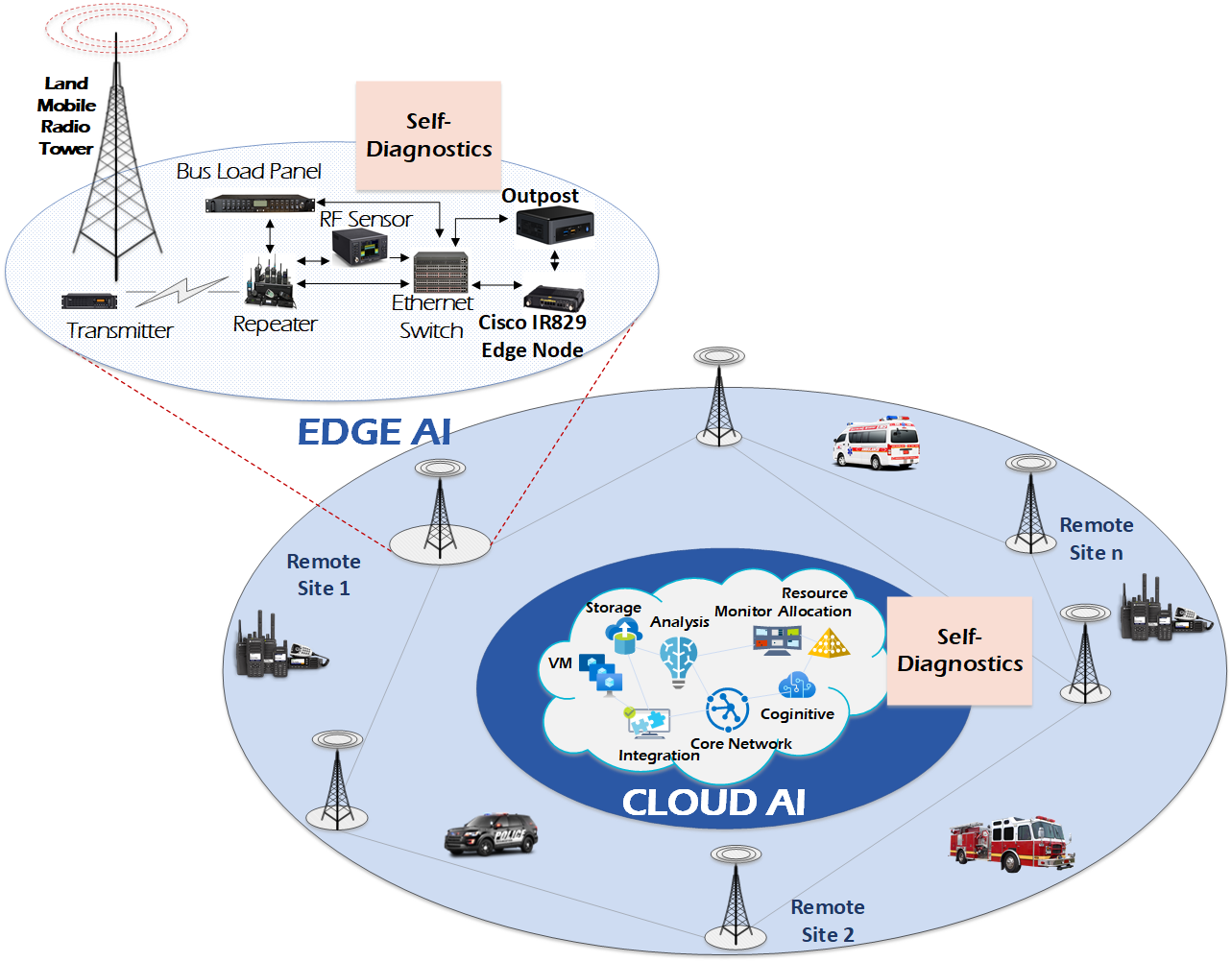
In urgent situations like natural disasters — or even the current pandemic — Canadian first-response teams rely on mobile radio systems to communicate in a fast and secure way. Manufacturers globally also use radio systems in their production plants. Enabling radio communications requires a complex infrastructure with hundreds of thousands of radio repeater sites spread across North America and the globe. Land mobile radio systems generate large amounts of operational data and system alarms on a daily basis. Most of this vital data goes unused and requires sending a technician out to manually investigate every alarm. Our AE Lab set out to collabrate with Rimot.io Inc under a MITACS-funded project to develop a platform capable of using machine learning to quickly and accurately identify sensor problems and, in turn, predict future issues, reduce outages, and improve the system’s reliability. We proposed combining cloud and edge computing to eliminate the distance and time it takes to send data to centralized sources.
[Publications] [Impact Story]
EV Platform
Smart Grid
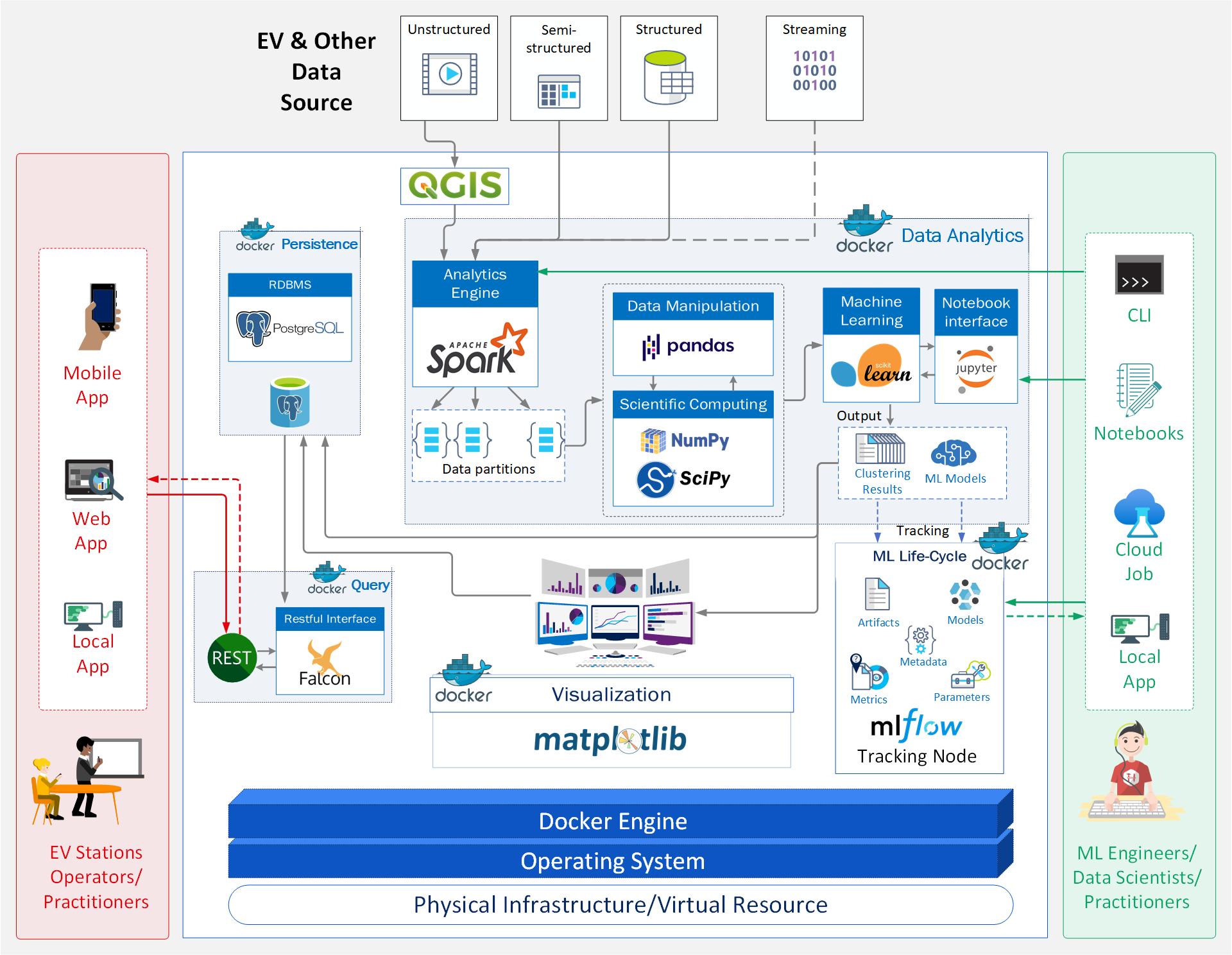
The commitments of authorities around the world to electrify the transportation sector will have an impact on air quality, sustainable mobility and the management of natural resources. In 2016, New Brunswick had the 3rd highest per-capita Green House Gas (GHG) emissions in Canada and 30% of these emissions came from the transportation sector. Moreover, 24% of GHG emissions were attributable to vehicles in Canada. Transport electrification introduces new opportunities in supporting sustainable mobility. Fostering Electric Vehicle (EV) adoption integrates vehicle range and infrastructure deployment concerns. An understanding of EV charging patterns is crucial for optimizing charging infrastructure placement and managing costs. We proposed an end-to-end platform prototype named “EVStationSIM” that allows for the creation of relative rankings of similar clustering results. The ultimate goal is to support users/practitioners by allowing them to identify and interpret similar clustering patterns of EV charging stations using multiple time slices. The performance of this proposed platform is demonstrated with a case study using real-world EV charging event data from charging station operators in New Brunswick, Canada. The case study illustrates how generated results can assist in downstream analytical tasks such as planning infrastructure allocation expansions.
[Publications]
Analytics Everywhere Framework
Generating new insights from the Internet of Things
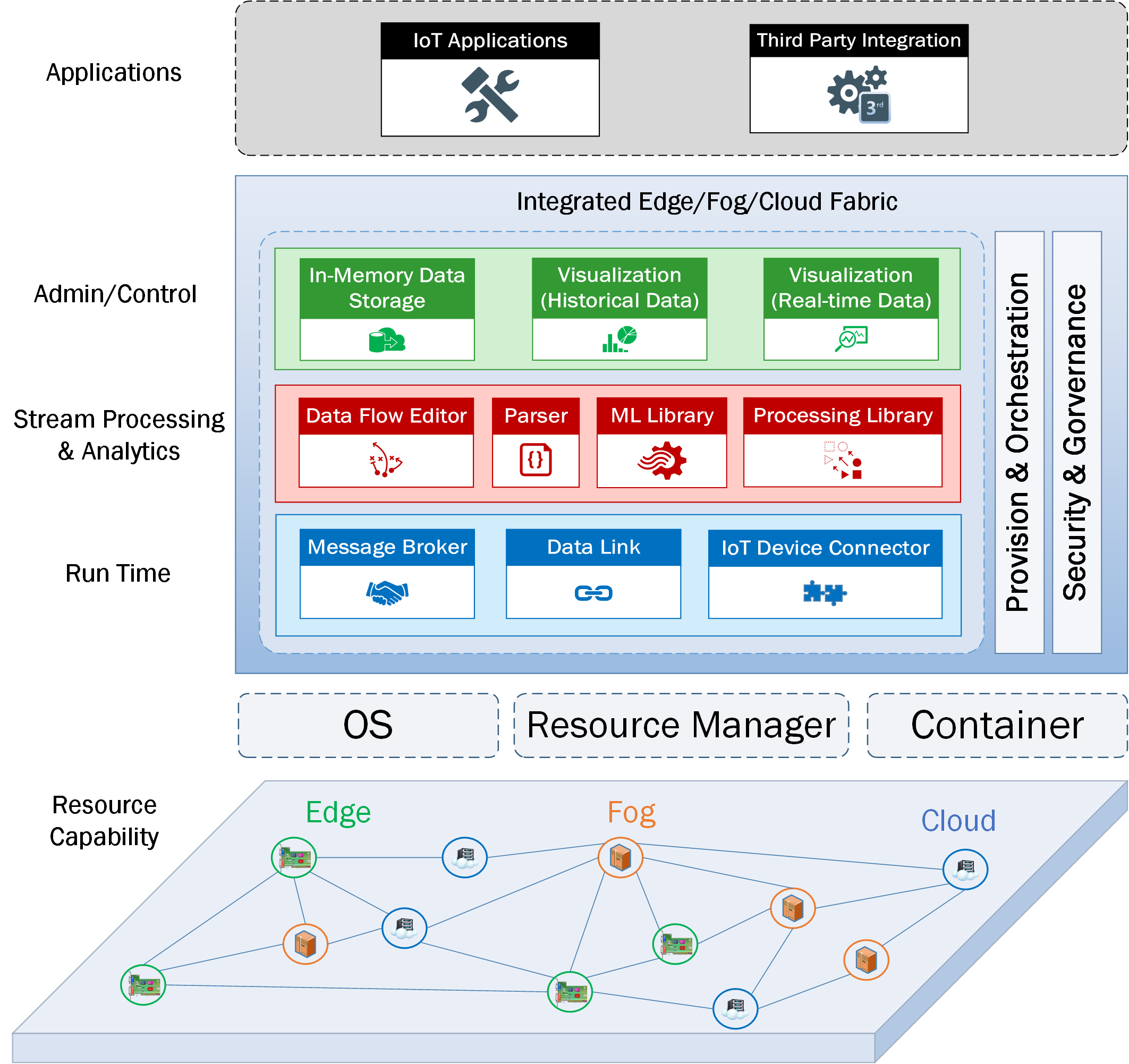
Analytics Everywhere is our proposed conceptual framework that is developed based on edge-fog-cloud continuum to handle an enormous volume of incoming data streams from IoT devices and perform a network of analytical tasks (different analytical capabilities such as descriptive, diagnostic, and predictive analytics) according to a data life-cycle. This major breakthrough framework provided us with an iterative learning experience on how to advance our research towards automated analytical tasks for the Internet of Things.
[Publications] [Demo]
Smart Transit
A smart city use case study
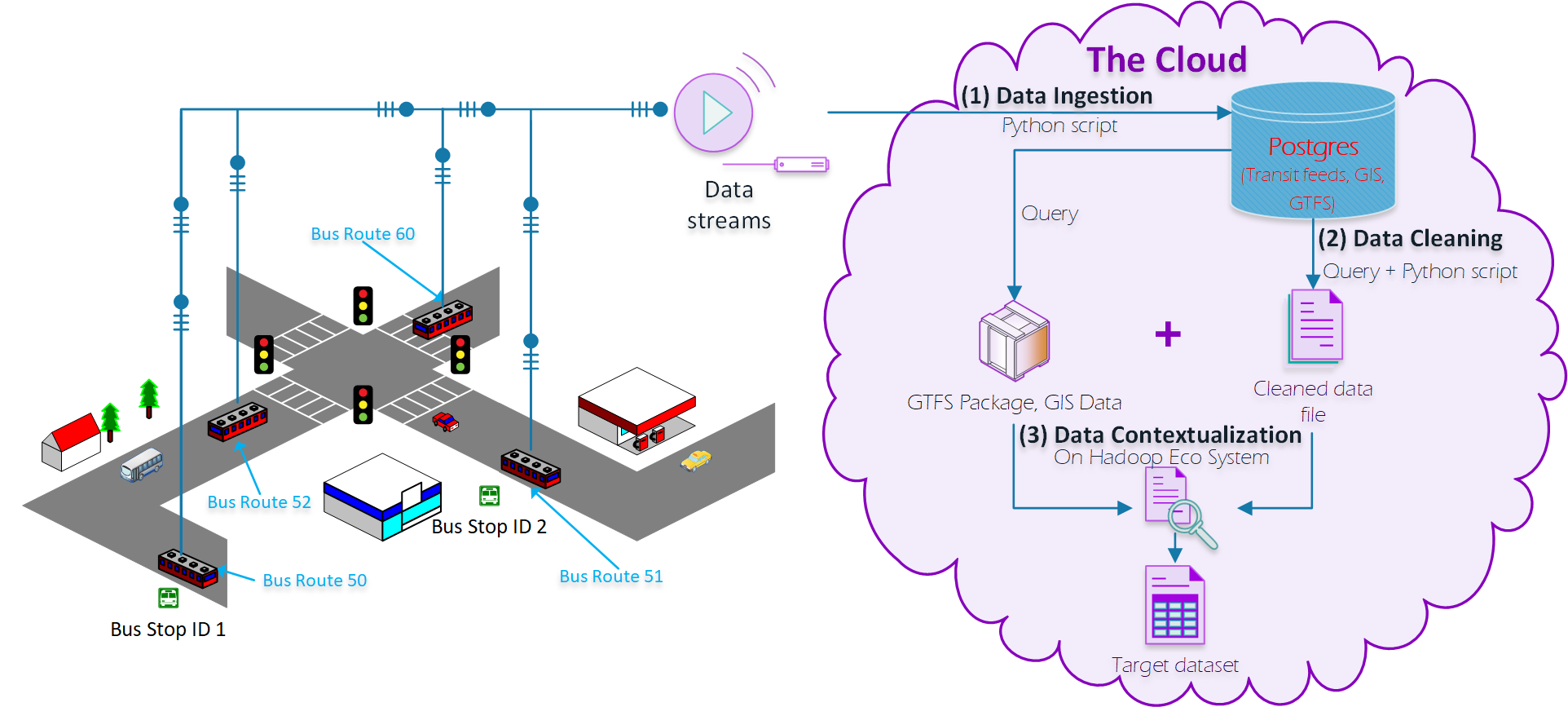
Small transit agencies tend to have limited resources for facing the challenges of continually increasing the high quality of the delivered transit services and reducing private car dependency while ensuring low operational costs, low environmental impact, and safety. Our smart transit case study aim at combining the current transit facilities with new technologies such as IoT, Analytics Everywhere, Advanced GIS, Edge/Fog/Cloud Computing Environment to be able to tranform them into a smart city service. The outcomes of this cutting edge research are not only pointing out to the improvement of fleet management effectiveness and efficiency by providing the right information at the right time and reducing staff workload and costs, but it can also support a variety of user groups such as bus drivers and passengers who are seeking new insights to optimize their decisions and adjust their behaviors. For example, bus drivers might be interested in knowing how their driving performance has been for the last week while passengers would be interested in how frequently the services are delivered on-time.
[Publications] [Case Study]
E-health
Social Good

An example for IoT Data Analytics for Social Good is E-health application. This is a joint research between AELab and colleagues at Flinders University, Australia to develop a novel multi-window analytical workflow for biosensor wearable data streams. We collect data from Fitbit devices and streaming them and building an analytical workflow to reveal individuals’ patterns that can yield new self-knowledge insights.
[Publications]
Scaling Electric Vehicle Integration in Digital Grids
Smart Grid
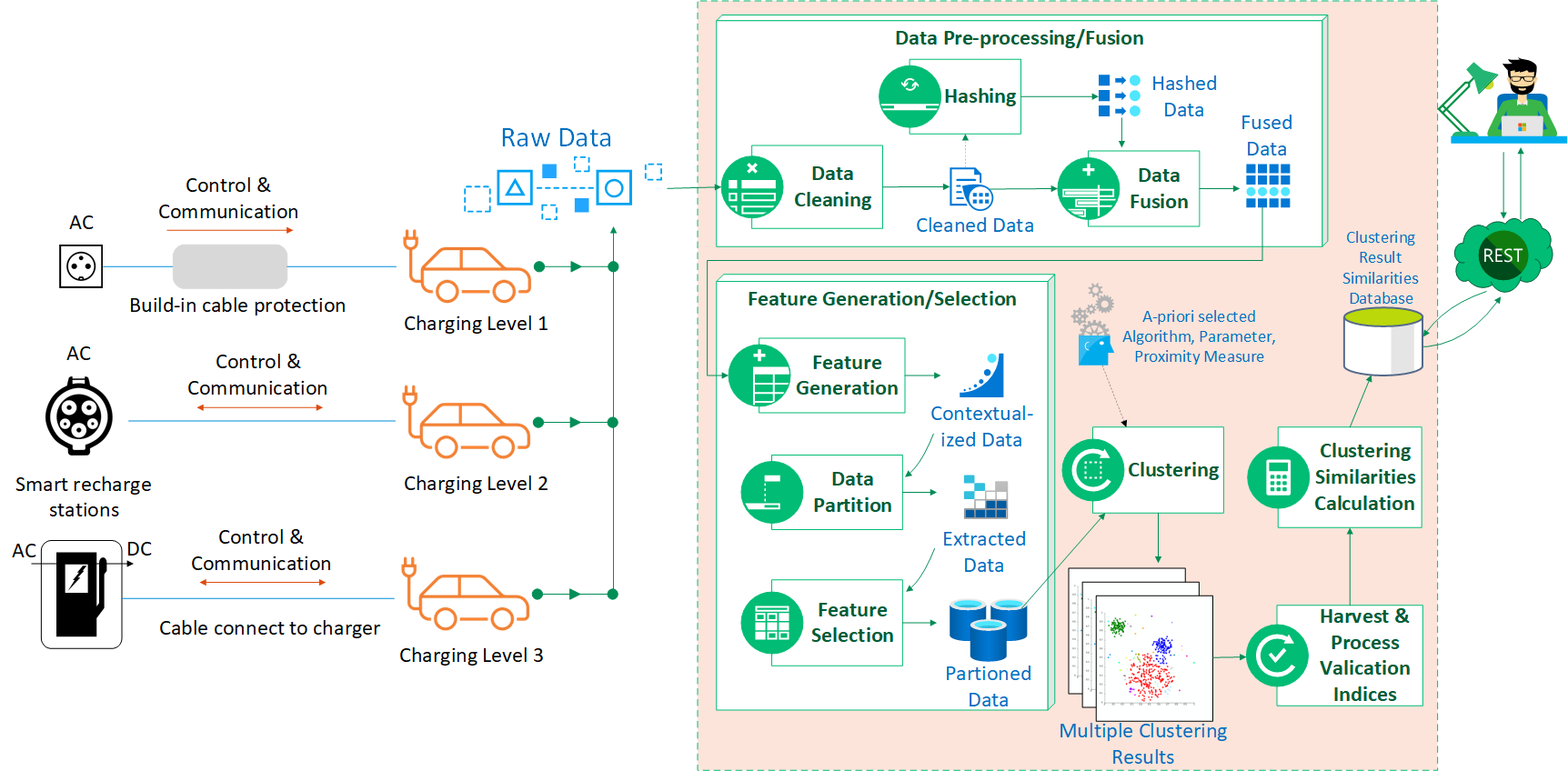
The Analytics Everywhere Framework was used to understand EV usage patterns in New Brunswick. We involveed in the research Theme 2: Scaling Electric Vehicle Integration in Digital Grids. In this project, we collaborate with NB Power, UNB Smart Grid group, Emera and Siemens Canada to develop new technologies for transforming EVs into distributed energy storage devices. We collect the EV charging data from NB power, and developing a machine learning framework for the aggregation, monitoring, optimization, and prediction for smart charging/discharging scheduling at the aggregator and Virtual Power Plant (VPP) levels.
[Publications]
Smart Parking
A smart city use case study
Exploring Internet of Things (IoT) data streams generated by smart cities means not only transforming data into better business decisions in a timely way but also generating long-term location intelligence for developing new forms of urban governance and organization policies. Studies have shown that integrating smart parking into the city framework can shorten parking search time, reduce emissions and fuel consumption and decrease traffic congestion. This IoT use case was carried out in conjunction with the City of Saint John Parking Commission and the HotSpot Parking Company. The IoT data was utilized from both organizations to build a parking prediction model for predicting whether a parking spot is occupied or vacant within the next hour, or the next day. Parking prediction systems can drastically decrease parking times between 20 and 40% in Saint John. This means improving traffic flow by up to 30% and a decreasing in carbon emissions due to a shorter trip time.
[Publications] [Demo]
Indoor Occupancy Prediction
Using non intrusive sensors and big data analytics
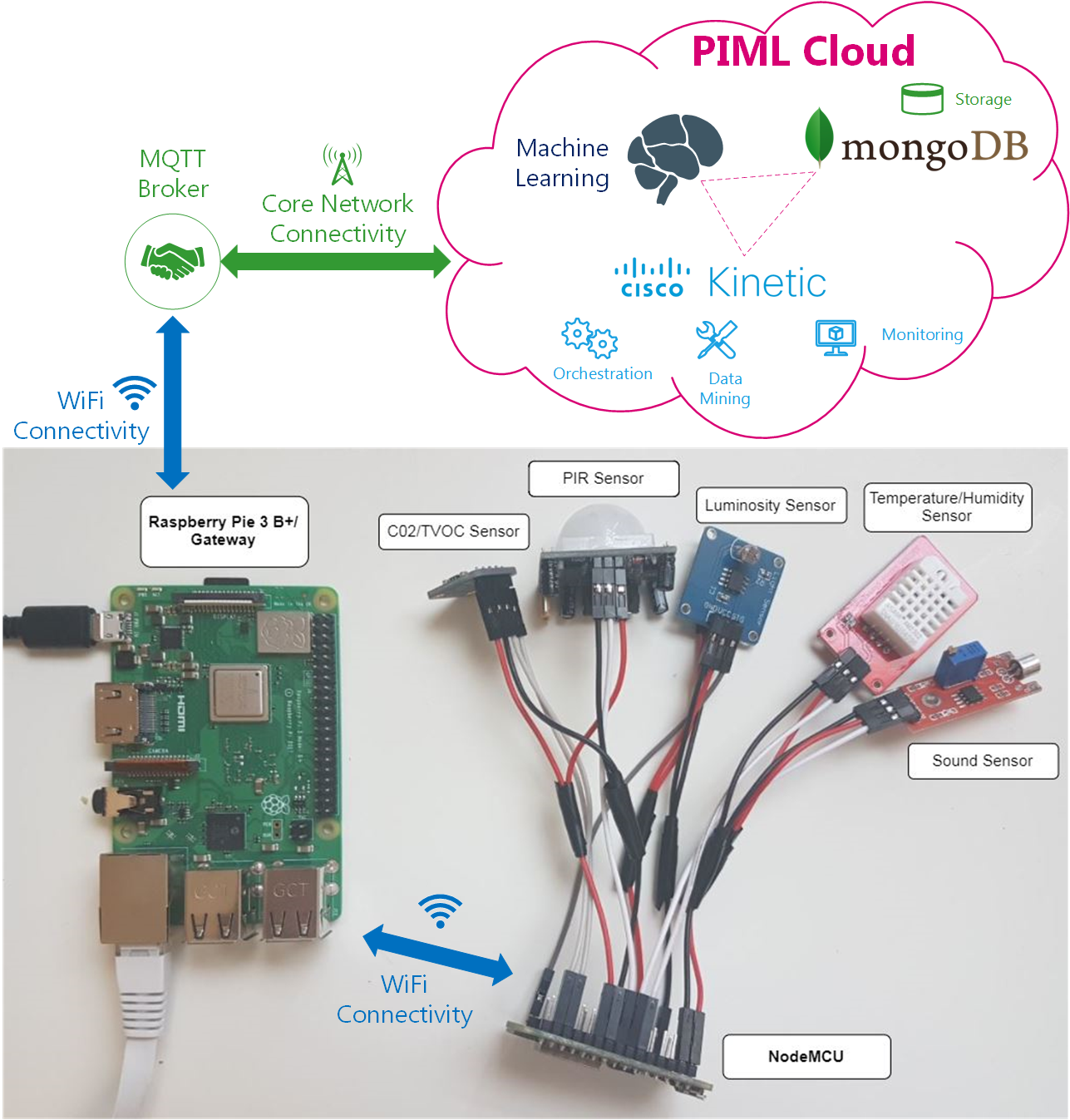
Current research in indoor sensor networks has pointed out an emerging interest in occupancy detection for Building Information Management (BIM), because buildings use 68% of Canada's energy in operation and contribute 17% of greenhouse gas (GHG) emissions. As Canada pursues its COP21 agreement, there is a critical need not only to ensure that new buildings are designed to minimize energy consumption, but to address the performance of the much larger area of existing buildings. This study aims at developing a non-intrusive sensing method for predicting occupancy towards reducing building emission while also promoting a comfortable and productive working environment, while retaining the privacy of occupants. Our proposed IoT platform has the ability to efficiently collect time series and event based raw IoT data obtained from a variety of on board sensors measuring intrinsic environmental information for occupancy prediction.
[Publications]
Air Polution Prediction in Fredericton
IoT for combatting Climate Change

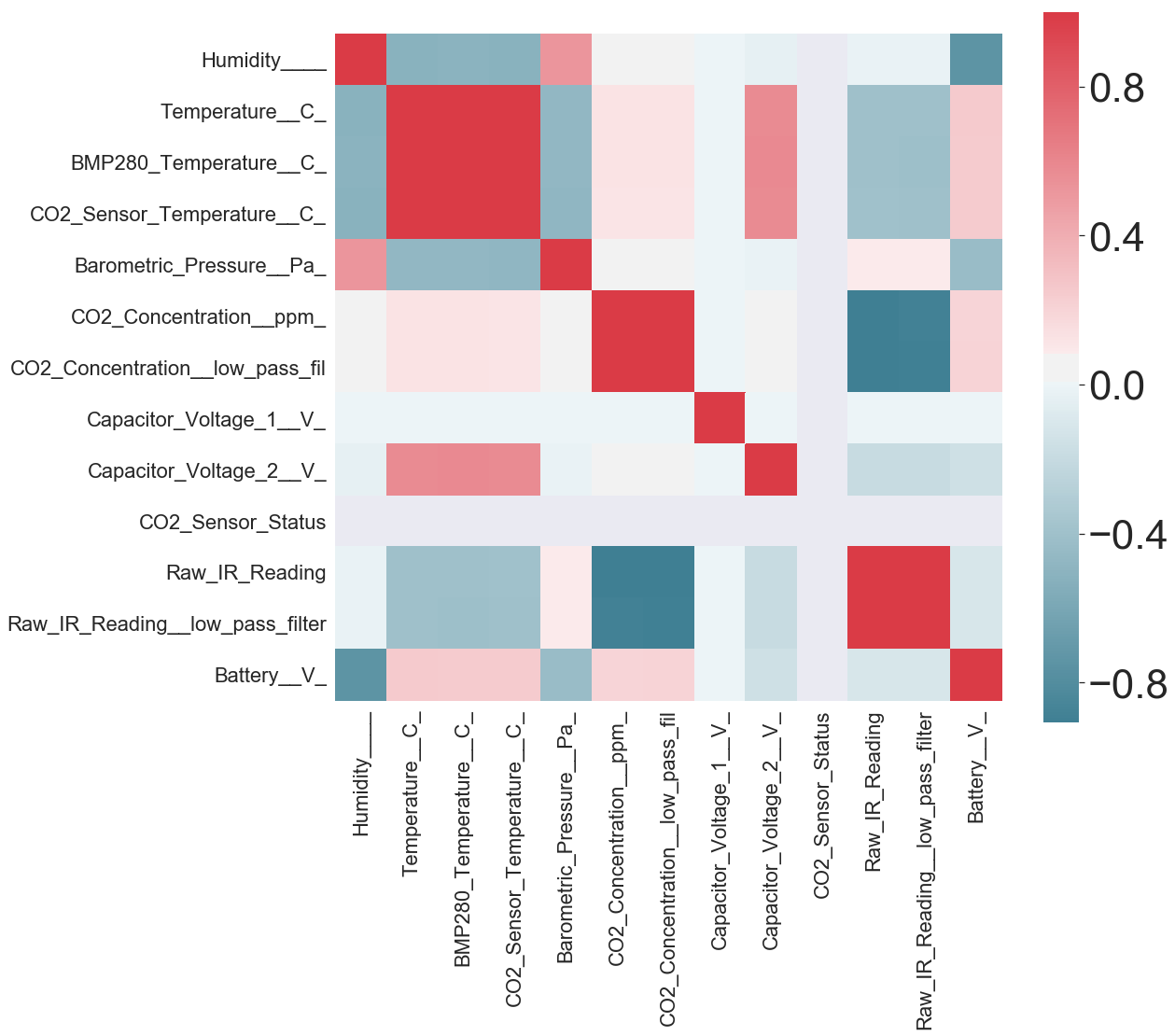
The city of Fredericton has partnered with eleven-x to deploy Internet of Things (IoT) sensors that enable real-time information and data collection from things previously impossible to monitor. Aiming to transform Frederiction into a smart city in the near future, the City is looking to innovate and develop new applications that are vital importance to the city such as real-time flood monitoring, parking occupancy monitoring using real-time connected sensors, quality of life applications for air and noise pollution, water consumption optimization and so on. We had developed a prototype to explore insights from open IoT data (provided by the City) collected through IoT devices/sensors that were deployed around the city (provided by Eleven-X). Our prototype used a deep learning prediction model (LSTM Model) and correlation model to be able to analyze and predict the air and noise pollution aiming to build an early detection and warning system for the people in the urban area. The prototype created by us won the Best Minimum Viable Product Award during 12 hours coding in Fred E-hack Smart City Hackathon.
[Presentation] [Code]
Processing a massive LiDAR dataset on the cloud
Cloud computing
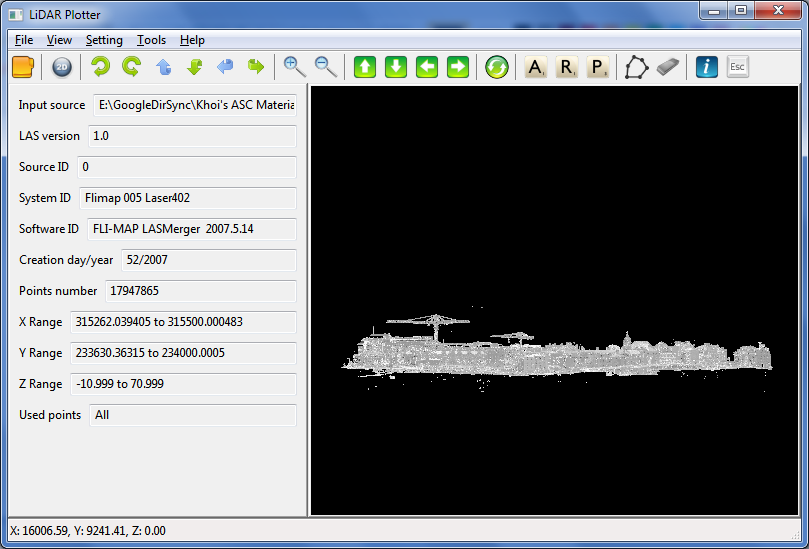
Air-borne Light Detection And Ranging (LiDAR) has been used to acquire three dimensional (3D) topographic data points of object’s surfaces of a large coverage area. The huge volumes and complexity of aerial laser scanning (ALS) data are to be great challenges for data processing as the limitation of the computing hardware. With conventional sequence algorithms, ALS data processing is to be time consuming because the processing is computationally intensive and iterative. This research proposed the cloud comping-based approaches to processing a huge volume of spatial LiDAR data. To harness cloud computing's advantages, an Octree data structure is implemented to index LiDAR points cloud on the Apache Hadoop framework using MapReduce parallel programing model.